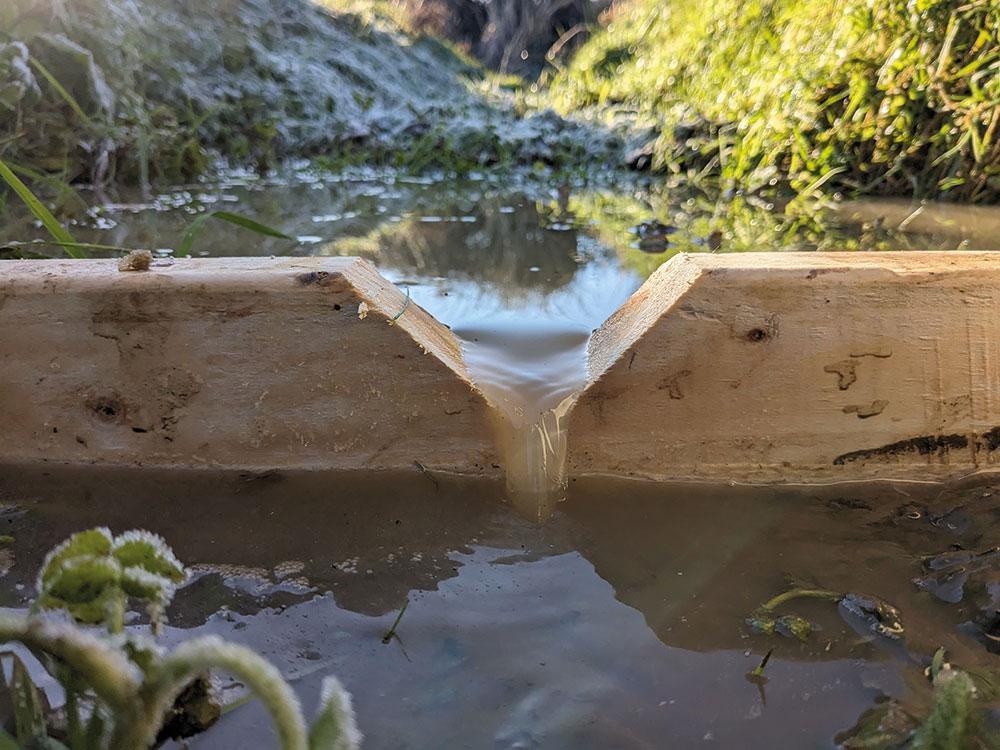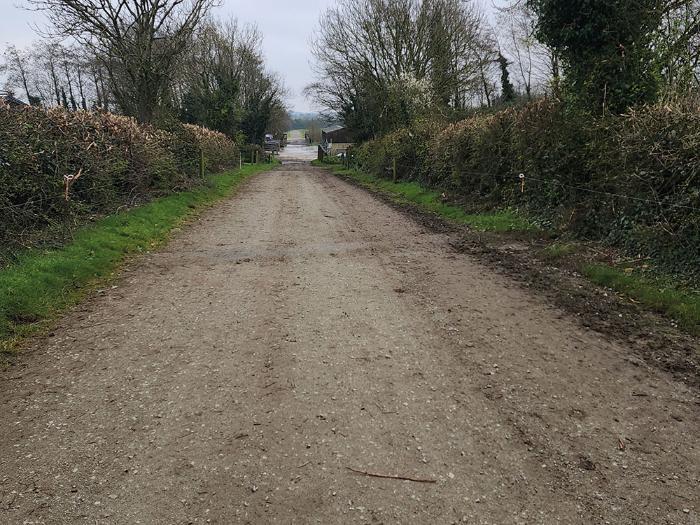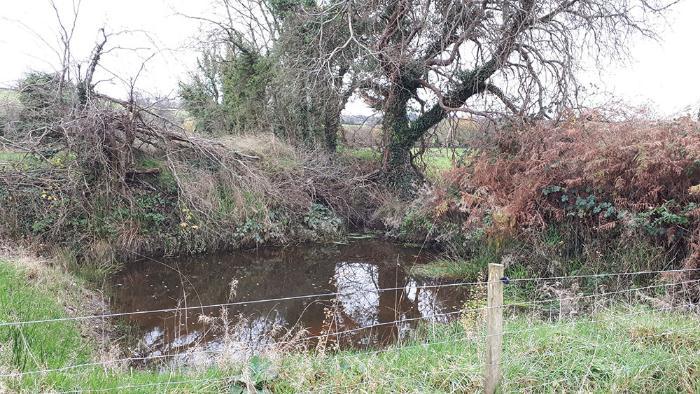21 August 2024
Slowing down to get ahead
With agriculture putting a strain on water quality, Teagasc researchers are developing farm-scale measures to break pollutant pathways and reduce nutrient and sediment runoff into waterbodies.

ln-drain measure to slow the flow of water in surface open drains in farm landscapes. Photo credit: Teagasc
Agriculture is putting significant pressure on water quality. The challenge is to connect national trends to local improvement efforts, particularly at farm level. Researchers at Teagasc have been working on water quality measures that could prevent nutrient and sediment from areas around farms infiltrating streams and rivers.
Water that flows across or drains through the farm landscape can carry nutrients, sediment and pesticides, causing problems when they enter local rivers, streams and groundwater bodies. When this occurs multiple times, the potential effect is a decline in water quality or, at best, no signs of improvement.
The campaign Better Farming for Water – 8-Actions for Change is a multi-actor initiative bringing research, advisory and policy professionals together with farmers to improve water quality and identify the measures and actions needed at local level. The campaign’s actions (see p.13) can be adopted at farm-scale to deliver improvements at waterbody scale.
Some of the simple but effective measures being developed by Teagasc include slowing the flow of water and breaking the pathway between sources of pollutants and delivery points to the stream, explains Principal Research Officer Karen Daly.
“This concept works well on features such as farm roadways and surface drainage ditches, which often act as networks or arteries around the farm that move sediment and water to small streams and rivers.”
Slowing the flow
Many farms are built on a complex network of in-field pipe or mole drains connecting with a surface open-ditch network, sometimes connected to a farmyard and discharging directly to surface waters or a drainage outlet.
“Traditionally,” says Karen, “in-field drains and surface open ditches were seen as a fully connected system installed to quickly remove excess water off the farm. To protect water quality, we need to understand the corridors for water movement on the farm that might bring pollutants with it.”
Open drainage ditches occur more frequently in low-lying areas prone to waterlogging as a result of low permeability soils or where the water table is shallow. Surface drainage ditches typically occur as boundary ditches between fields on the farm connected at an outflow and which carry water directly to a stream or river. Drainage ditches can quickly move excess water away from agricultural land, roads and yards and potentially transport sediment and nutrients.
This type of drain poses the greatest risk for transporting nutrients, says Karen. “In some cases, these can also drain across the farm boundary through neighbouring land. These ‘connected’ ditches aim to prevent waterlogging. However, if we can avoid contaminants such as nutrients and pesticides from entering these ditches, water quality in the receiving streams will be protected.”
The actions for these features include in-ditch, pathway-control measures to mitigate nutrient loss by breaking the pathway between the farm and the waterbody. In general, these measures aim to slow the flow of water so that the nutrient and sediment being carried by the water is dropped, and to allow nitrogen and phosphorus to be attenuated. These include sediment traps, such as a small dam feature installed within the surface open drain, and sediment ponds to allow water to pond and settle out sediment and attenuate nutrients. It’s important that installed measures are maintained and cleaned out, otherwise they risk nutrients such as phosphorus accumulating in the sediment settling in the pond.
Breaking the pathway
There is little research in Ireland on the composition, pathways and impacts of roadway runoff entering waterbodies. Solutions to halt roadway runoff entering streams are also part of the research at Teagasc.
The dominant nutrient losses are from fresh animal deposits, but another source stems from nutrients stored in the roadway materials themselves. During the closed period when animals are housed, high concentrations of nutrients can be washed out of roadway materials during rainfall all year round, and runoff from farm roadways can negatively impact water quality.
To help reduce the soiling of runoff waters, key intervention points on farmyards have been identified, including a 100-metre radius around the farmyard; underpasses and waiting areas associated with underpasses; and water troughs along roadways, roadway junctions or anywhere that impedes animal movement. Connectivity with water can occur directly – runoff into drains, rivers, lakes, etc. – or indirectly, for example on farmyards. Targeted mitigation aims to break the connectivity between the nutrient source on the roadway and waters. Examples include cambering roads towards fields, diversion bars or berms to direct runoff away from open waters, and moving entry points to paddocks away from the water course to reduce sediment or nutrient entering.

Road camber installed on farm roadway breaks the pathway and diverts runoff into neighbouring fields. Photo credit: Teagasc
In conclusion, our research shows that by adopting measures such as slowing water flow and disrupting pollutant pathways, farms can significantly reduce nutrient and sediment runoff – and the collective effort at local level can enhance water quality on a broader scale.
If every farm takes one or two actions from the Better Farming for Water campaign, including slowing the flow and breaking the pathway, we can move the dial at national level and get ahead of our water quality targets.
Better Farming for Water campaign
8-Actions for Change
- Reduce purchased nitrogen and phosphorus surplus per hectare.
- Ensure soil fertility is optimal for lime, phosphorus and potassium.
- Ensure application of fertiliser and organic manure at appropriate times and conditions.
- Have sufficient slurry and soiled water storage capacity.
- Manage and minimise nutrient loss from farmyards and roadways.
- Fence off watercourses to prevent bovine access.
- Promote targeted use of mitigation actions such as riparian margins, buffer strips and sediment traps to mitigate nutrient and sediment loss to water.
- Maintain over-winter green cover to reduce nutrient leaching from tillage soils.

A sediment pond intercepting nutrients and sediment in the farm landscape. Photo credit: Teagasc
Funding
Teagasc; Department of Agriculture, Food and the Marine; and the Environmental Protection Agency.
Contributors
Karen Daly, Head of Environment, Soils & Land Use, Department, Teagasc Johnstown Castle.
Owen Fenton, Principal Research Officer, Teagasc Johnstown Castle.
Patrick Tuohy, Senior Research Officer, Teagasc Moorepark.
Find out more about the ‘Better farming for water – 8-Actions for Change’ campaign at this link: Better farming for water
